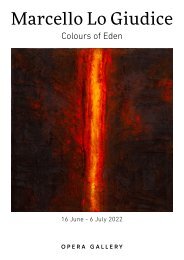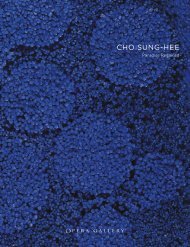AMERICAN-ICONS-WEB2
Create successful ePaper yourself
Turn your PDF publications into a flip-book with our unique Google optimized e-Paper software.
TOM<br />
WESSELMANN<br />
1931 - 2004<br />
Tom Wesselmann est né en 1931 à Cincinnati (Ohio) aux États-Unis. Il commence<br />
à réaliser des bandes dessinées durant son service militaire dans l’US Army en<br />
1952. Après sa démobilisation, il termine ses études de psychologie et de dessin à<br />
l’Université de Cincinnati. Il s’installe à New York après avoir obtenu ses diplômes et<br />
devient membre fondateur de la Judson Gallery, où il expose pour la première fois<br />
son œuvre fondatrice The Great American Nude. Au cours des années suivantes, il<br />
expérimente avec les motifs patriotiques, les images publicitaires, des objets trouvés<br />
et des assemblages pour former un esthétisme qui juxtapose des éléments et des<br />
représentations contrastés. Bien que régulièrement associé au mouvement pop art,<br />
Wesselmann se distance souvent du groupe en indiquant que ses œuvres intègrent,<br />
plutôt que critiquent, l’objet consumériste dans son art.<br />
En 2005, le Museo d’Arte Contemporanea de Rome organise une rétrospective de son<br />
œuvre, suivie l’année suivante par une exposition majeure à la galerie L&M Arts à New<br />
York. Ses œuvres sont également exposées dans de nombreux musées et institutions<br />
comme le Museum of Modern Art et le Whitney Museum of American Art à New York.<br />
Tom Wesselmann was born in Cincinnati, Ohio, USA in 1931. He began producing<br />
cartoons while serving stateside in the US Army in 1952, and after his discharge<br />
completed degrees in psychology and drawing from the University of Cincinnati.<br />
He moved to New York shortly after graduating and became a founding member of<br />
the Judson Gallery, where he first exhibited his seminal piece The Great American<br />
Nude. Over the next few years he experimented with patriotic motifs, advertising<br />
images, found objects and assemblages in an aesthetic that juxtaposed contrasting<br />
elements and depictions. While most closely associated with the Pop Art movement,<br />
Wesselmann often distanced himself from the group in the claim that his works<br />
incorporated, rather than critiqued, the consumerist object in his art.<br />
In 2005, the Museo d’Arte Contemporanea di Roma held a retrospective of his work,<br />
followed by a major exhibition the following year at L&M Arts in New York. His works are<br />
also been exhibited at the Museum of Modern Art, New York and the Whitney Museum<br />
of American Art, New York, among numerous other museums and institutions.<br />
87
















